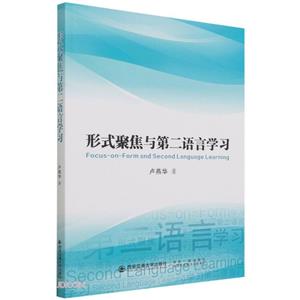扫一扫
关注中图网
官方微博
本类五星书更多>
-
>
心灵元气社
-
>
县中的孩子 中国县域教育生态
-
>
(精)人类的明天(八品)
-
>
厌女(增订本)
-
>
这样学习才高效/杨慧琴
-
>
心理学经典文丛:女性心理学
-
>
中国文化5000年
形式聚焦与第二语言学习 : 英文 版权信息
- ISBN:9787569320022
- 条形码:9787569320022 ; 978-7-5693-2002-2
- 装帧:一般胶版纸
- 册数:暂无
- 重量:暂无
- 所属分类:>
形式聚焦与第二语言学习 : 英文 内容简介
本书的主要研究对象为“形式聚焦”,即在以意义为中心的课堂中采用一定的技巧和手段把学生的注意力引向语言形式。它所涉及的形式及意义的关系及语法教学问题分别是第二语言习得研究和外语教学领域的重点问题,其背后的理论基础跟认知心理学研究中的热点问题“注意”密切相关。 基于“注意假设”,本研究发现了“注意层次”对学习的影响,丰富了“形式聚焦”的理论基础。除“形式聚焦”方式外,本书还对“任务类型”对注意和学习产生的影响进行了研究,结果表明注意力不仅受到“聚焦方式”的影响,也受到具体任务要求和实施该任务的具体条件的制约。
形式聚焦与第二语言学习 : 英文 目录
Chapter 1 Introduction
1.1 Research background
1.1.1 Form and meaning within a cognitive framework
1.1.2 Form-focused and meaning-focused approach in second language pedagogy
1.1.3 Focus-on-form
1.2 Goal of research
1.3 Research questions
1.4 Research significance
1.5 Structure of the book
1.6 Summary
Chapter 2 Literature Review
2.1 Noticing and SLA
2.1.1 Noticing Hypothesis
2.1.2 Attention, awareness and noticing in SLA
2.1.3 Different types of noticing
2.2 Focus-on-form
2.2.1 Meaning-focused approach, focus-on-forms and focus-on-form
2.2.2 Definitions of FonF and different related terms
2.2.3 Theoretical explanations for FonF
2.3 Input enhancement and output stimulation
2.3.1 Input enhancement and textual enhancement
2.3.2 Output stimulation
2.4 Tasks in L2 research and pedagogy
2.4.1 Definitions of task
2.4.2 Principles for using tasks in L2 classrooms
2.4.3 Empirical studies investigating tasks
2.5 Limitations of the previous studies and justifications for thepresent study
2.6 Summary
Chapter 3 Theoretical Foundations
3.1 Information Processing model and Output Hypothesis
3.1.1 Information Processing model
3.1.2 Output in the integrated model of second language acquisition
3.2 Izumi's model featuring noticing in relation to overall SLA processes
3.3 The theoretical foundations for the present study
3.4 Summary
Chapter 4 Research Design
4.1 Research questions and hypotheses
4.2 Method
4.2.1 Participants
4.2.2 Linguistic target
4.2.3 Input materials used in the study
4.2.4 Instruments
4.2.5 Research design
4.3 Summary
Chapter 5 Results and Discussion
5.1 The noticing issue
5.1.1 Phase 1 underlining
5.1.2 Phase 2 underlining
5.1.3 Results from questionnaires and interviews
5.1.4 Discussion
5.2 The immediate uptake issues
5.2.1 The immediate uptake
5.2.2 The effect of task types
5.2.3 Results from questionnaires and interviews
5.2.4 Discussion
5.3 Effects of the three FonF approaches on promote learning
5.3.1 The effects of the three FonF approaches on promoting learning in Phase 1
5.3.2 The effects of the three FonF approaches on promoting learning in Phase 2
5.3.3 The retention of the effects of the three FonF approaches on promoting learning
5.3.4 The overall developmental trends of the four groups
5.3.5 Results from questionnaires and interviews
5.3.6 Discussion
5.3.7 Summary
Chapter 6 Conclusions
6.1 Major research findings
6.2 Implications for teaching
6.2.1 Practicing FonF in L2 classrooms
6.2.2 Use of textual enhancement in EFL context
6.2.3 Use of oral output in EFL context
6.3 Limitations and suggestions for future research
6.3.1 Limitations in general and suggestions for future research
6.3.2 Limitations of the research design of the experiment
6.3.3 Limitations of the TE treatment and suggestions for future research
6.3.4 Limitations of the Oral Output treatment and suggestions for future research
6.3.5 Other factors to be investigated in the future
6.4 Summary
References
Appendices
1.1 Research background
1.1.1 Form and meaning within a cognitive framework
1.1.2 Form-focused and meaning-focused approach in second language pedagogy
1.1.3 Focus-on-form
1.2 Goal of research
1.3 Research questions
1.4 Research significance
1.5 Structure of the book
1.6 Summary
Chapter 2 Literature Review
2.1 Noticing and SLA
2.1.1 Noticing Hypothesis
2.1.2 Attention, awareness and noticing in SLA
2.1.3 Different types of noticing
2.2 Focus-on-form
2.2.1 Meaning-focused approach, focus-on-forms and focus-on-form
2.2.2 Definitions of FonF and different related terms
2.2.3 Theoretical explanations for FonF
2.3 Input enhancement and output stimulation
2.3.1 Input enhancement and textual enhancement
2.3.2 Output stimulation
2.4 Tasks in L2 research and pedagogy
2.4.1 Definitions of task
2.4.2 Principles for using tasks in L2 classrooms
2.4.3 Empirical studies investigating tasks
2.5 Limitations of the previous studies and justifications for thepresent study
2.6 Summary
Chapter 3 Theoretical Foundations
3.1 Information Processing model and Output Hypothesis
3.1.1 Information Processing model
3.1.2 Output in the integrated model of second language acquisition
3.2 Izumi's model featuring noticing in relation to overall SLA processes
3.3 The theoretical foundations for the present study
3.4 Summary
Chapter 4 Research Design
4.1 Research questions and hypotheses
4.2 Method
4.2.1 Participants
4.2.2 Linguistic target
4.2.3 Input materials used in the study
4.2.4 Instruments
4.2.5 Research design
4.3 Summary
Chapter 5 Results and Discussion
5.1 The noticing issue
5.1.1 Phase 1 underlining
5.1.2 Phase 2 underlining
5.1.3 Results from questionnaires and interviews
5.1.4 Discussion
5.2 The immediate uptake issues
5.2.1 The immediate uptake
5.2.2 The effect of task types
5.2.3 Results from questionnaires and interviews
5.2.4 Discussion
5.3 Effects of the three FonF approaches on promote learning
5.3.1 The effects of the three FonF approaches on promoting learning in Phase 1
5.3.2 The effects of the three FonF approaches on promoting learning in Phase 2
5.3.3 The retention of the effects of the three FonF approaches on promoting learning
5.3.4 The overall developmental trends of the four groups
5.3.5 Results from questionnaires and interviews
5.3.6 Discussion
5.3.7 Summary
Chapter 6 Conclusions
6.1 Major research findings
6.2 Implications for teaching
6.2.1 Practicing FonF in L2 classrooms
6.2.2 Use of textual enhancement in EFL context
6.2.3 Use of oral output in EFL context
6.3 Limitations and suggestions for future research
6.3.1 Limitations in general and suggestions for future research
6.3.2 Limitations of the research design of the experiment
6.3.3 Limitations of the TE treatment and suggestions for future research
6.3.4 Limitations of the Oral Output treatment and suggestions for future research
6.3.5 Other factors to be investigated in the future
6.4 Summary
References
Appendices
展开全部
形式聚焦与第二语言学习 : 英文 作者简介
卢燕华,广西桂林人,西安交通大学外国语学院英语教师,上海外国语大学英语语言文学博士;主要研究领域为二语习得、外语教学;博士阶段师从我国知名外语教育家戴炜栋先生;近年来,在核心期刊等刊物上发表二语习得和外语教学相关论文5篇,主编、参编教材3部,主持“中央高校基本科研业务费专项资金”1项,参与各级科研及教改项目数项;曾获校级授课竞赛一等奖、校级教学成果二等奖、“陕西高等学校大学英语教学学术研讨会”教学论文一等奖,指导学生在全国英语写作大赛中获陕西省特等奖。
书友推荐
- >
名家带你读鲁迅:故事新编
名家带你读鲁迅:故事新编
¥13.0¥26.0 - >
唐代进士录
唐代进士录
¥25.5¥39.8 - >
李白与唐代文化
李白与唐代文化
¥8.9¥29.8 - >
伯纳黛特,你要去哪(2021新版)
伯纳黛特,你要去哪(2021新版)
¥15.9¥49.8 - >
苦雨斋序跋文-周作人自编集
苦雨斋序跋文-周作人自编集
¥5.8¥16.0 - >
小考拉的故事-套装共3册
小考拉的故事-套装共3册
¥36.7¥68.0 - >
罗庸西南联大授课录
罗庸西南联大授课录
¥13.8¥32.0 - >
月亮虎
月亮虎
¥14.4¥48.0
本类畅销
-
字海探源
¥25¥78 -
《标点符号用法》解读
¥8.3¥15 -
文言津逮
¥10.2¥28 -
那时的大学
¥12¥28 -
现代汉语通用字笔顺规范
¥19.6¥58 -
2020年《咬文嚼字》合订本
¥23.8¥60





















